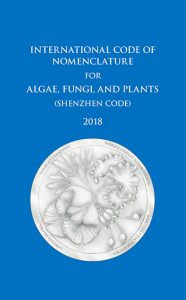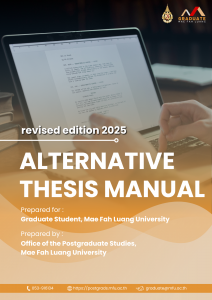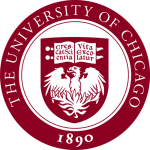Alternative Thesis Manual Revised edition 2025
Components
The preparation of a dissertation or thesis is an essential part of graduate-level education. Students must ensure that the document includes three primary sections:
- Preliminary Section
- Body of Text Section
- Appendices Section
The format of these sections must strictly adhere to the university’s guidelines as outlined in this manual.
Preliminary Section
The preliminary section consists of the following components:
Body of the Text Section
1. Background and Importance of the Research Problem
It provides the background to and significance of the problem, as well as presenting the rationale for the study, in order to explain why the problem is worth investigating. The introduction may also discuss a problematic phenomenon and its potential solution. Whichever the case, the introduction has to discuss related or applicable theories and previous studies to support the rationale.
2. Research Objectives
It states the objective(s) and goal(s) of the study. The objective(s) and goal(s) must be related to the background given in the introduction. In case there are two or more objectives and goals, they are to be itemized in the order of significance.
3. The Importance of Research
It states the significance of the study, which outlines two major types of benefits the study may offer: (1) academic significance: the new or improved body of knowledge, principles or theories; and (2) applicational significance: potential application of research outcomes to developing or improving policies or their implementation.
4. Research Hypothesis
It gives a set of hypotheses, or projected outcomes of the study. The hypotheses, which must be related to the objectives and literature reviewed, will be tested in the course of research. A survey study, however, may not have a hypothesis.
5. Scope of Research
It sets a scope of the study by delimiting such factors as the sample population, data-gathering sites, research duration and so forth, all of which serve as criteria with reference to which research results will be discussed.
6. Preliminary Agreement
It states preliminary conventions or agreements between the researcher and the reader in terms of methods, conditions or instruments of the study. In other words, it is the section in which the researcher informs the reader of how the research will be conducted and concluded, such as the reason for the reliability of the questionnaire, the respondents’ confirmation of their truthful answers or unbiased sampling of subjects.
7. Research Limitations
It states limitations of the study, by explaining problems or unfavorable conditions that can potentially cause drawbacks to the study, such as a too small population or insufficient data-gathering time.
8. Terminology Definition
It provides a list of definitions of technical terms as they are used in the context of that particular study, in order to ensure the reader’s accurate understanding of those terms.
The literature review section presents contents, concepts, theories or any findings relevant to the study being conducted. Such relevancy should be in both content and research methodology terms.
Reviewed parts of relevant literature MUST NOT be copied or summarized and pasted chronologically. Instead, they must be paraphrased and re-expressed in the researcher’s own words and integrated with the researcher’s points to separately discuss each significant aspect of the study.
1. Conclusion
The conclusion part shall provide a concise but complete summary of the contents of the study, namely, the objectives, hypotheses, methodology and the relevant results or findings, in keeping with the theoretical framework employed. By NO means may the results of other studies, personal opinions or prejudiced remarks be included in this chapter. Reference to or citation of any supporting statements is NOT necessary.
2. Discussion
The discussion part shall attempt to address the acquired knowledge in a critical manner, by clearly and thoroughly discussing its possible causes or reasons in accord with the objectives and hypotheses. In addition, the researcher shall discuss his/her work in the light of other researchers’ works and state clearly whether and how his/her work supports or contradicts them. Finally, the researcher shall identify and explain his/her work’s academic impact or contribution, or in what way it may confirm, refute or redefine existing concepts in the given academic field.
3. Suggestion
The recommendation part shall present suggestions concerning different aspects of the study and its findings. This part provides two kinds of suggestion. (1) It suggests potential benefits or application of the study’s outcomes. (2) It recommends courses of further research to more comprehensively address other aspects of the problem.
Appendices Section
This section includes additional details relevant to the content, such as the name of the person who provided the information, questionnaires, or interview transcripts used to gather data. These materials serve to enhance the understanding of the content and enrich the overall presentation. If the information is presented as a table or image, it should be formatted consistently with the main content. If applicable, any document certifying human ethics must be included.
(If alternative format, a copy of the previously published article must be included as Appendix A)
This section provides a summary of the author’s personal and professional information, including their first name, last name, educational background (specifying only completed degrees at the bachelor’s level or higher), work experience (if applicable), scholarships (if any), and publications (if any). The information should be listed in reverse chronological order, with the most recent items appearing first.
If this section is not required, it may be omitted. Alternatively, it should be prepared according to the specified format if included.
Printing Requirements
General Requirements
Use the “Times New Roman” font throughout the document.
Use Arabic numerals with the “Times New Roman” font throughout the document.
Use 1.5 line spacing throughout the document.
Top and left margins: 1.5 inches from the edge of the paper.
Right and bottom margins: 1 inch from the edge of the paper.
- Use justified alignment.
- Leave one character space between sentences, letters, numbers, and symbols.
- Ensure that there are no excessive spaces between words.
Indent the first line of each paragraph by 0.5 inches. For subheadings or additional content, indent an additional 0.25 inches.
- If the last word of a line does not fit, move the entire word to the next line rather than splitting the word.
- Keep the same word on the same line, such as the author’s name, chemical name, country name, etc.
If a new paragraph starts, but there is a significant amount of empty space left at the end of the page, start the new paragraph on the next page, or adjust based on the appropriateness of the content.
Page Numbering and Sequence
Do not include page numbers for the preliminary section.
Number pages starting from page 1, beginning from the first page of Chapter 1 to the last page of the author’s biography. The page numbers should be placed in the top right corner, 1 inch from both the top and right edges of the paper.
Include page numbers for all pages following the main content section.
Page numbers should be placed at the bottom right corner of the paper, 1 inch from both the right and bottom edges of the paper. The horizontal page number should align with the vertical page number.
Division of Chapters, Topics within Chapters, and Content of Each Topic
The number of chapters is at the discretion of the advisor.
When starting a new chapter, begin on a new page. Type “Chapter” followed by the chapter number, centered on the page. Use a bold font size of 14 points.
Leave a space of 2 lines after “Chapter” and type the chapter name centered on the page. Use a bold font size of 14 points. If the chapter name exceeds one line, break it into two or three lines as appropriate, following an inverted triangle arrangement. The key is to divide the words appropriately.
Main Topic
Main topics are the first-level headings (e.g., 1.1, 2.1) and should be written in a bold font size of 14 points.
- The heading number should align with the left margin, with a space of about 2 characters between the number and the heading text.
- If the heading is longer than one line, ensure that the second and subsequent lines align with the first letter of the heading on the first line.
- Leave a 2-line space from the previous line. After the main heading text, leave 2 lines of space before continuing with the content or the subheading.
- Content under the main topic: Indent the first line of the content by 0.5 inches from the left margin. Subsequent lines should be aligned with the left margin.
Sub-Topic
Sub-topics are second-level headings (e.g., 1.1.1, 2.1.1), and should be in a 12-point font.
- The sub-heading number should be indented by 0.5 inches from the left margin. Leave about 2 characters of space between the number and the heading text.
- If the sub-heading extends beyond one line, the second and subsequent lines should align with the left margin.
- The first line of the content should align with the sub-heading number, with no extra line spacing. Subsequent lines should be aligned with the left margin.
Minor Topics and Further Subsections or Itemized Content
Use a regular 12-point font for minor topics or itemized points.
- Type the topic number and text as required by the university’s format, with a space of about 2 characters between the number and the topic text.
- If the topic name exceeds one line, the second and subsequent lines should align with the left margin.
- For the content, align the first line with the topic number, with no extra line spacing. Subsequent lines should be aligned with the left margin.
Scientific Names

Scientific reference to an animal and plant is made using a binomial nomenclature consisting of a generic term (or genus), whose first letter is capitalized, and a specific term (or epithet), whose first letter is NOT capitalized. The generic and specific terms are separated by one space and are both italicized. In case of a scientific name to which the name of the designator and additional information are appended, but the designator’s name and additional information shall be typed in the regular style.
Ex. Borassus flabelifer
Artocarpus heterophyllus Lam.
Amomum krervanh Pierre
Eugenia caryophyllum Bullock & Harrison
Table/ Figure
1. Clarity of Tables
Tables must be clear and not appear as images. The table format should adhere to the university’s standards.
2. Table Numbering
The table should be labeled as “Table” followed by the table number (in bold). Use the chapter number followed by the table number (e.g., Table 2.1, Table 4.5). If the table title is one line, center the text. If the title is longer than one line, left-align the text.
3. Table Title
The title should be typed in regular font following the table number, with 2 characters of space between the table number and the title. If the table title exceeds one line, continue on the next line, aligning the continuation of the title with the first part of the title.
4. Spacing
Leave a 2-line or 24-point space after the table before continuing with the next paragraph.
5. Table Borders
1. The width of the table borders should match the paper’s margins.
2. If the table is large, reduce the font size of the text and numbers in the table, but ensure clarity and ease of reading.
3. Use horizontal lines for borders. The top and bottom of the table should be closed with double lines. Use a single line for the separation between the header and the table contents.
4. If the table spans multiple pages, use a single line at the bottom of the table, and a double line to close the table on the last page.
6. Table Content
1. Table Headers: Use bold text for table headers and center the text within each cell.
2. Table Text: Ensure a balanced layout for the text in each cell.
3. Table Numbers: Align numbers by their units. If using decimals, ensure that all numbers have the same number of decimal places, with decimal points aligned.
4. Long Tables: If a table is too long to fit on one page, continue it on the next page. Label it with the table number followed by “(continued)” (e.g., Table 2.1 (continued)). The header should be repeated on the following page.
5. Landscape Tables: For tables that are too wide to fit within the page’s margins, rotate the table to landscape orientation. Set the paper layout to landscape mode.
6. Table Notes: If there are notes related to the table, place them immediately below the table. Type the word “Note” in bold, aligned with the left margin, and leave 2 character spaces before writing the note. If the note exceeds one line, continue it on the next line, aligning the continuation with the first part of the note.
7. Table Source: If the table was sourced from another publication, type “Source” in bold, aligned with the left margin, followed by the citation in name-year format (e.g., Author, Year). Include the full bibliographic reference of the source in the references section at the end of the document.
8. Continuing Table Notes and Sources: For long tables that continue over multiple pages, repeat the table notes and sources on the final page of the table.
9. Table Description: When describing a table, refer to it by its table number, such as “from Table 4.5…”, rather than using terms like “the table above,” “the table below,” or “the table on the next page.”
1. Figures and Graphics
This includes figures, diagrams, maps, charts, and chemical structures, all of which should be clear, centered on the page, and within the page margins.
2. Figure Numbering
The figure should be labeled as “Figure” followed by the figure number (in bold), using the chapter number followed by the figure number (e.g., Figure 2.1, Figure 4.5). If the figure title is one line, center the text. If the title is longer than one line, left-align the text.
3. Figure Title
The title should be typed in regular font following the figure number, with 2 character spaces between the figure number and the title. If the title exceeds one line, continue it on the next line, aligning the continuation with the first part of the title.
4. Spacing
Leave a 2-line or 24-point space after the figure title before continuing with the next paragraph.
5. Continuing Figure
If a figure cannot fit on the same page, place the remainder of the figure on the next page. Label it with the figure number followed by “(continued)” (e.g., Figure 2.1 (continued)), without repeating the title.
6. Landscape Figures
If a figure is too wide for the page, rotate it to landscape orientation. Set the page layout to landscape mode.
7. Figure Notes
If there are notes related to the figure, place them immediately below the figure. Type the word “Note” in bold, aligned with the left margin, and leave 2 character spaces before writing the note. If the note exceeds one line, continue it on the next line, aligning the continuation with the first part of the note.
8. Figure Source
If the figure is sourced from another publication, type “Source” in bold, aligned with the left margin, followed by the citation in name-year format (e.g., Author, Year). Include the full bibliographic reference of the source in the references section at the end of the document
9. Continuing Figure Notes and Sources
For figures that span multiple pages, repeat the figure notes and sources on the final page of the figure.
10. Figure Description
When describing a figure, refer to it by its figure number, such as “ From Figure 4.5…”, rather than using terms like “the figure above,” “the figure below,” or “the figure on the next page.”
Example Table
References
In-text Citation
In-text citation refers to the identification of the sources from which the author has taken information to include in their writing. This indicates where the data originates and provides bibliographic details of the source in the references list.
In-text citations and references must correspond to each other. That is, the sources cited within the text must appear in the reference list, and each item in the reference list must be referenced in the text.
Mae Fah Luang University has established four citation formats that students can choose from:
- American Psychological Association (APA)
- Vancouver
- Chicago
- Turabian
The student may select one of the formats for their citations, as shown in the examples below.
Citing the author’s surname and the year of publication in the content is necessary to indicate the source of the information. When directly quoting or referencing an idea or part of a text, the page number should also be included. The in-text citation format is as follows:
- The author’s surname and the year of publication should be placed in parentheses at the end of the sentence, with a comma between the author’s surname and the year of publication, for example:
Biosynthesis of theanine occurs in tea plants from glutamic acid and ethylamine via the enzyme theanine synthetase, it occurs mainly in the roots and subsequently transferred to the developing shoots (Deng et al., 2008).
- The author’s surname is integrated into the sentence, with the year in parentheses.
According to Holland and Jeremy (2005) postulation, the inflammatory processes underlying acne vulgaris represent a preclinical phenomenon that precedes the onset of comedogenic or inflammatory lesions.
- Page numbers (if available): Use “p.” (for one page) or “pp.” (for multiple pages).
Work characteristics are key factors influencing job satisfaction, especially when the job holds meaning. Salary, comfort in the workplace, and job security are secondary factors (Lawler & Hall, 1970, pp. 15-20).
Bacharach and Bamberger (1990, p. 12) conducted research . . .
Citing by referencing the number of the source within the content you are referencing, by placing the number in parentheses ( ) or using superscript. The numbering should begin with 1, 2, 3, and so on, sequentially throughout the document.
Biosynthesis of theanine occurs in tea plants from glutamic acid and ethylamine via the enzyme theanine synthetase, it occurs mainly in the roots and subsequently transferred to the developing shoots (1) or 1
- For citing multiple sources in a continuous sequence in the text, use a hyphen (-) between the numbers.
There is still mutual dependence, and cooperation is essential for the philosophy of education to achieve its goals (3-5) or 3-5
- For citing multiple sources that are not in a continuous sequence, use a comma (,) between the numbers.
There is still mutual dependence, and cooperation is essential for the philosophy of education to achieve its goals (3,12) or 3,12
- If citing the same source again, repeat the same number.
Citing by specifying the author’s surname and publication year within the text to indicate the source of the information. When directly citing content, a specific concept, or quoting a portion of text from the original, the page number should also be included. The in-text citation methods are as follows.
- Specify the author’s surname, and the publication year in parentheses at the end of the text.
Biosynthesis of theanine occurs in tea plants from glutamic acid and ethylamine via the enzyme theanine synthetase, it occurs mainly in the roots and subsequently transferred to the developing shoots (Deng et al. 2008).
- Including page numbers (if available) in the citation. For instance,
Work characteristics are key factors influencing job satisfaction, especially when the job holds meaning. Salary, comfort in the workplace, and job security are secondary factors.” (Lawler and Hall 1970, 15-20)
The Turabian citation style has two formats:
- In-text Citation:
This format involves citing the source of the information by using the name-year citation style. The author’s surname and the publication year are placed within the text, such as:
Biosynthesis of theanine occurs in tea plants from glutamic acid and ethylamine via the enzyme theanine synthetase, it occurs mainly in the roots and subsequently transferred to the developing shoots (Deng et al. 2008).
- Footnote Citation:
This method places references at the bottom of each page, where the citation number is used in two places: once at the end of the text and again in the corresponding footnotes at the bottom of each page, numbered sequentially.
Biosynthesis of theanine occurs in tea plants from glutamic acid and ethylamine via the enzyme theanine synthetase, it occurs mainly in the roots and subsequently transferred to the developing shoots1
1 Wei W. Deng, Shinjiro Ogita, and Hiroshi Ashihara. “ Biosynthesis of theanine (γ-ethylamino-l-glutamic acid) in seedlings of Camellia sinensis,” Phytochemistry Letters 2, no.1 (2008): 115-119, https://doi.org/10.1016/j.phytol.2008.06.002
Reference
References are a list of bibliographic information for the documents cited throughout the content (except for sources that are not publicly available, such as private letters or conversations). They must correspond to the citations in the text.
Each reference entry must include accurate and complete bibliographic details according to the specified format.
- Ordering the Reference List: References should be ordered alphabetically from A to Z, without separating by document type.
- Guidelines for Listing Bibliographic Entries in the References: For detailed instructions, see the Office of the Postgraduate Studies website.
Example:
Bacharach, S. B., & Bamberger, P. (1990). Exit and voice: Turnover and militancy intentions in elementary and secondary schools. Educational Administration Quarterly, 26(4), 316-344.
Deng, W. W., Ogita, S., & Ashihara, H. (2008). Biosynthesis of theanine (γ-ethylamino-l-glutamic acid) in seedlings of Camellia sinensis. Phytochemistry Letters, 1(2), 115-119. https://doi.org/10.1016/j.phytol.2008.06.002
Holland, D. B., & Jeremy, A. (2005). The role of inflammation in the pathogenesis of acne and acne scarring. Seminars in Cutaneous Medicine and Surgery, 24(2), 79-83.
Lawler, E. E., & Hall, D. T. (1970). Relationship of job characteristics to job involvement, satisfaction, and intrinsic motivation. Journal of Applied psychology, 54(4), 305.
- Ordering the Reference List: The references should be arranged in numerical order (1, 2, 3, …) without separating by document type.
- Guidelines for Listing Bibliographic Entries in the References: For detailed instructions, see the Office of the Postgraduate Studies website.
Example:
1 Lawler EE, Hall DT, Relationship of job characteristics to job involvement, satisfaction, and intrinsic motivation. Journal of Applied psychology. 1970; 54(4):305.
2 Bacharach SB, Bamberger P, Exit and voice: Turnover and militancy intentions in elementary and secondary schools. Educational Administration Quarterly. 1990; 26(4):316-344.
3 Deng WW, Ogita S, Ashihara H, Biosynthesis of theanine (γ-ethylamino-l-glutamic acid) in seedlings of Camellia sinensis. Phytochemistry Letters. 2008; 1(2):115-119. https://doi.org/10.1016/j.phytol.2008.06.002
4 Holland DB, Jeremy A. The role of inflammation in the pathogenesis of acne and acne scarring. Seminars in Cutaneous Medicine and Surgery. 2005; 24(2):
79-83.
- Ordering the Reference List: References should be ordered alphabetically from A to Z, without separating by document type.
- Guidelines for Listing Bibliographic Entries in the References: For detailed instructions, see the Office of the Postgraduate Studies website.
Example:
Bacharach, Samuel B., and Bamberger, Peter. “Exit and voice: Turnover and militancy intentions in elementary and secondary schools.” Educational Administration Quarterly 26, no. 4 (1990): 316-344.
Deng, Wei W., Ogita, S., and Ashihara, H. “Biosynthesis of theanine (γ-ethylamino-l-glutamic acid) in seedlings of Camellia sinensis.” Phytochemistry Letters 2, no. 1 (2008): 115-119. https://doi.org/10.1016/j.phytol.2008.06.002
Holland, Diana B., and Jeremy, A. “The role of inflammation in the pathogenesis of acne and acne scarring”. Seminars in Cutaneous Medicine and Surgery 24, no. 2 (2005): 79-83.
Lawler, Edward E., and Hall, Douglas T. “Relationship of job characteristics to job involvement, satisfaction, and intrinsic motivation.” Journal of Applied psychology 54, no. 4 (1970): 305.
- Ordering the Reference List: References should be ordered alphabetically from A to Z, without separating by document type.
- Guidelines for Listing Bibliographic Entries in the References: For detailed instructions, see the Office of the Postgraduate Studies website.
Example:
Bacharach, Samuel B., and Bamberger, Peter. “Exit and voice: Turnover and militancy intentions in elementary and secondary schools.” Educational Administration Quarterly 26, no. 4 (1990): 316-344.
Deng, Wei W., Ogita, S., and Ashihara, H. “Biosynthesis of theanine (γ-ethylamino-l-glutamic acid) in seedlings of Camellia sinensis.” Phytochemistry Letters 2, no. 1 (2008): 115-119. https://doi.org/10.1016/j.phytol.2008.06.002
Holland, Diana B., and Jeremy, A. “The role of inflammation in the pathogenesis of acne and acne scarring”. Seminars in Cutaneous Medicine and Surgery 24,
no. 2 (2005): 79-83.
Lawler, Edward E., and Hall, Douglas T. “Relationship of job characteristics to job involvement, satisfaction, and intrinsic motivation.” Journal of Applied psychology 54, no. 4 (1970): 305.
If you have questions, please contact us.








